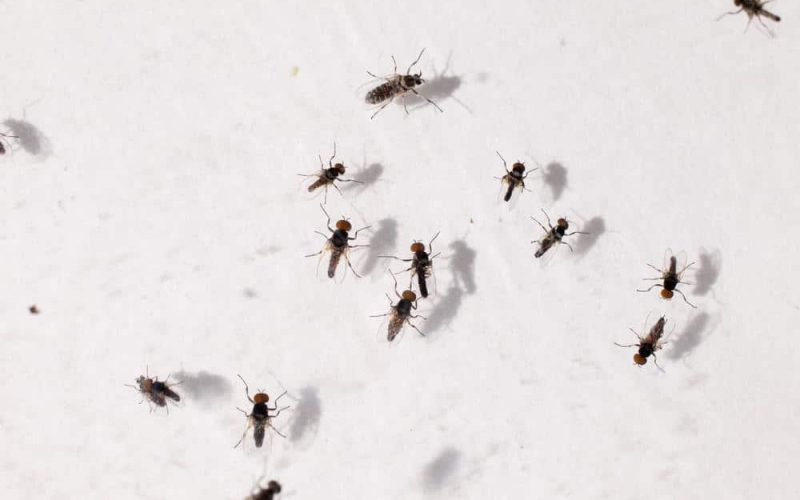Gnats are tiny, annoying insects that seem to increase during summer. There are many different types of gnats.
The one thing they all have in common is their unpleasant tendency to swarm around any and every human being who happens to be nearby.
Disrupting conversations, causing physical discomfort, and generally getting in the way of enjoying the great outdoors with friends and family members.
Here’s a list of different types of gnats that may cause you grief this summer if you aren’t ready for them.
1. Blow Flies
Blowflies are gnats that get their name from their tendency to be attracted to dead and decaying animals.
They can also spread disease due to their contact with rotting flesh.
Over 1,000 species of blowflies are found worldwide, making them a global problem.
The most common type in North America is the green bottle fly. These flies are about 1⁄4 inch long and have a metallic green body.
In addition, they’re attracted to garbage cans, pet food, and any other food that’s been left out.
If you see one in your home, it’s best to remove it immediately, as they can lay up to 500 eggs at a time!
2. Buffalo Gnats
Of all the different gnats, buffalo gnats are perhaps the most annoying. These pests are attracted to moisture and can often be found near stagnant water or damp areas.
Also, they are attracted to humans, making them a nuisance when enjoying time outdoors.
Buffalo gnats are small, dark-colored insects that can be difficult to spot. But their presence is often made known by their constant biting.
In addition, these bites can be painful and irritating. If you’re dealing with a buffalo gnat infestation, there are a few things you can do to get rid of them. But it’s always best to contact a professional for help.
3. Common Housefly
The common housefly is one of the most ubiquitous types of gnat. As its name suggests, it’s often found in homes, but it can also be found in other buildings and outdoors.
Houseflies are attracted to food and garbage, so they’re often found near kitchens and other places where food is prepared or stored. Because these insects can carry diseases, it’s essential to keep them away from food.
4. Drain Flies
The scientific name for drain flies is Psychoda phalaenoides. They’re small – about 1/8 to 1/4 inch long – and have a moth-like appearance.
The wings are fringed and often rest with them folded over their bodies.
They’re also known as sewer moths, filter flies, or sink flies. If you see tiny black bugs flying around your drains, they’re likely drain flies.
5. Drain Fly
Drain flies might be the most annoying of the different types of gnats. They’re often found near drains or other standing water sources, where they lay their eggs.
When the eggs hatch, the larvae feed on organic matter in the water. This can include things like hair, grease, and other gunk that’s accumulated in your drain.
If you have a drain fly problem, you’ll likely notice them near your bathroom sink or shower. To get rid of them, you’ll need to clean out your drains and remove any standing water where they’re breeding.
6. Eye Gnats
Eye gnats are small, dark-colored flies attracted to moisture, such as tears. They are often found near water sources, such as ponds or streams.
Despite their name, eye gnats do not lay their eggs in the eye. Instead, they lay their eggs on the ground near water sources.
The larvae then hatch and enter the water to feed on microscopic organisms.
7. Dung Flies
Dung flies are small, dark-colored flies often found near decaying organic matter sources, like manure.
As their name suggests, they’re attracted to dung, which they use as a food source.
While they don’t bite humans, their presence can be a nuisance. There are two main dung flies: house flies and stable flies.
House flies are the most common type of fly found in homes. They’re about 1⁄8 inch long and have a gray or tan body with four dark stripes on their thorax.
Stable flies are attracted to food and garbage, which they can contaminate with their saliva and feces. At about 3/16 inches long, stable flies are slightly larger than house flies.
8. Fruit Flies
These small, brown insects are often found near fruit. While they don’t carry disease, they can be a nuisance in your home.
If you have a problem with fruit flies, try placing a piece of fruit in a jar with some vinegar. The flies will be attracted to the fruit and drown in the vinegar.
9. Fungus Gnats
These tiny black bugs are commonly found near damp areas, indoors and out. Although they don’t bite, their constant presence can be annoying.
Furthermore, fungus gnats are attracted to moist soil, so if you have them in your home, they’re likely coming from your houseplants.
To get rid of them, start by letting the soil dry out for a few days. If that doesn’t work, you may need to use an insecticide.
10. Gall Gnats
Gall gnats are a type of fungus gnat that is attracted to plants with high moisture content. Their larvae feed on plant tissue, which can damage the plant.
Adult gall gnats are small, dark-colored flies often seen near the soil surface.
If you have plants that are being damaged by gall gnats, you may be able to control them by removing affected leaves and stems and increasing air circulation around the plant.
11. Hessian Fly
The Hessian fly is also one of the gnats that attack wheat plants. The fly lays its eggs on the plant, and the larvae feed on its tissues.
Meanwhile, this feeding can cause the plant to wilt and die. The Hessian fly is native to Europe but has been introduced to North America, where it is a severe pest of wheat crops.
There are several types of Hessian flies, each with a preferred host plant.
The most common type in North America is the wheat strain, which attacks wheat plants.
12. Highland Midges
Highland midges are a type of gnat that is particularly bothersome to humans.
They are small, dark-colored insects that bite humans and animals, causing itching and swelling.
Highland midges are found in Scotland and Ireland but have also been known to travel to other parts of the world.
There are many highland midges, but the most common ones are the Culicoides impunctatus and the Culicoides brevitarsis.
13. Midges
Midges are also on the list of gnats, a small fly found near bodies of water. They are often mistaken for mosquitoes, but they do not bite.
Midges can be a nuisance because they fly in large swarms and can be challenging to avoid.
There are many different types of midges, including the following:
- The Non-biting Midge – This type of midge does not bite or feed on blood. They are attracted to light and often swarm around porch lights or streetlights.
- The Chironomid Midge is also called a bloodworm because it is red. It is commonly found in stagnant water and is known to bite humans.
14. Sand Flies
Sand flies are small flies commonly found near bodies of water. They bite humans and animals and can cause skin irritation.
There are many different species of sand flies, but they all have similar life cycles.
The female sandfly lays her eggs near a water source, and the larvae hatch and feed on organic matter.
They will mate once they mature into adults, and the cycle will start over again.
15. Stable Flies
Stable flies are one of the most common types of gnats. They’re often found near livestock, where they get their name.
These gnats are blood-suckers, and they’re known for being aggressive biters. If you have a stable fly problem, you’ll likely see them near areas where animals are kept.
16. Horse Flies
Horse flies are another type of gnat commonly found near livestock. Like stable flies, they’re attracted to animal blood and will bite humans if given a chance.
These gnats can be particularly troublesome because their bites can be very painful.
If you have a horse fly problem, you’ll likely see them near areas where animals are kept.
17. Unique-Headed Bugs
Have you ever been outside on a warm day, enjoying the sunshine, when suddenly a tiny bug starts flying around your head? If so, you’ve probably encountered a unique-headed bug called a gnat.
These small insects are annoying pests that can be found in many different environments.
There are several different types of gnats, each with unique characteristics.
Conclusion
There are many different types of gnats, but they all have one thing in common: they’re annoying!
Whether buzzing around your head or biting you, these little insects can ruin a good time. Luckily, there are ways to get rid of them.








